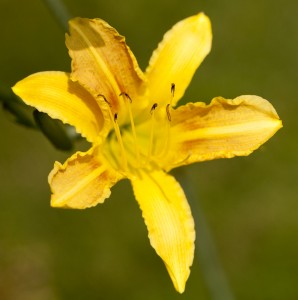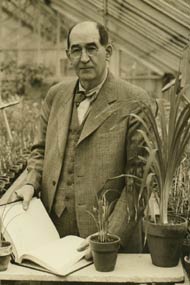Dr. Stout’s Daylily Dalliance
Posted in Around the Garden, People on July 2 2012, by Matt Newman
 Ever grown a daylily? For flower gardeners, it’s likely; they’re now some of the most ubiquitous flowers kept among horticultural circles, rivaling even roses in their widespread adoration. From the 20 original species found in the wilds of India, Japan, China and Mongolia, we now have tens of thousands of recognized cultivars on the market–the fan following of this flower is nothing to scoff at. But we owe the modern fame of Hemerocallis to a single man, one whose work at The New York Botanical Garden birthed an industry.
Ever grown a daylily? For flower gardeners, it’s likely; they’re now some of the most ubiquitous flowers kept among horticultural circles, rivaling even roses in their widespread adoration. From the 20 original species found in the wilds of India, Japan, China and Mongolia, we now have tens of thousands of recognized cultivars on the market–the fan following of this flower is nothing to scoff at. But we owe the modern fame of Hemerocallis to a single man, one whose work at The New York Botanical Garden birthed an industry.
To this day, Daylily Walk‘s early summer show can and does sneak up on us. The sloping path begins along Garden Way, the road that runs past the Library Building. From there it branches in a curving swoop around the Garden Café before joining Perennial Way by the Enid A. Haupt Conservatory. The walk leads you through thickets of conifers, bordered in late June by hundreds of daylilies in the colors of sunset, pomegranate seed, and safety cone orange. Think of a ribbon of rainbow sorbet connecting two of the NYBG’s most iconic pieces of architecture.
[Not a valid template]
Many of the flowers you see above can be traced, circuitously or otherwise, to the work of one Arlow Burdette Stout, who began as a Wisconsin student botanist only to find himself in a 36-year career as an NYBG geneticist, plant breeder, and educator. 1911 marked the year that he began as our Director of Laboratories, though he wouldn’t earn his Ph.D. until 1913. I think that says a little something about the man’s savvy.
During his tenure, Stout revolutionized the cultivation of the avocado by discovering the tree’s tendency to daily change the sex of its flowers. His work also saw the genesis of the seedless grape now bagged and stacked in every supermarket. But, as notable as those contributions were, it was his obsessive effort with the daylily that sustains his legacy. In 1938, NYBG Head Curator Henry A. Gleason perhaps best framed the impact of his colleague’s work:

“It is not unlikely that the commercial value of the work of Dr. A. B. Stout . . . will exceed the entire cost of the Garden during the forty years of its history.”
Before Stout, a habit of self-sterility in daylily species–an inability for a flower to pollinate itself–made it difficult to propagate them without failure. Nearly 50,000 cross-pollination experiments later, Stout had all but reinvented the flower. He introduced over 100 resplendent new hybrids of his own creation, invigorating interest in Hemerocallis, and soon became a pied piper to the breed: nursery horticulturists and home cultivators worldwide soon took his success and ran with it. And today, thanks to A. B. Stout, there are over 45,000 recognized daylily cultivars.
These come-and-go flowers can be a little fickle with their schedules, though. Sometimes daylily plants will bloom for only a single week, while others push out flowers for up to five. A few varieties, known as “rebloomers,” boast two blossoming cycles during the season. So, while there’s no way I can guarantee that the cultivars you see above will still be flaunting their finer sides when you visit, now is absolutely the time to honor Daylily Walk with a short stroll. Or perhaps I should say that you’re honoring Dr. Stout by admiring our collection. Sans his tireless dedication, would these outrageous blooms be anything but a quiet novelty?
In the few years between his retirement and his death in 1957, Stout eulogized his career with an understatement nonetheless poignant:
With daylilies
We have done
What
We leave done
Now
We are done
With daylilies
Today, the American Hemerocallis Society honors Stout and the horticulturists to have followed him with the Stout Silver Medal, an annual honor given to the most impressive daylily cultivar to come of that year’s nominees. You’ll run into a few of the recent years’ crowned winners along Daylily Walk!

